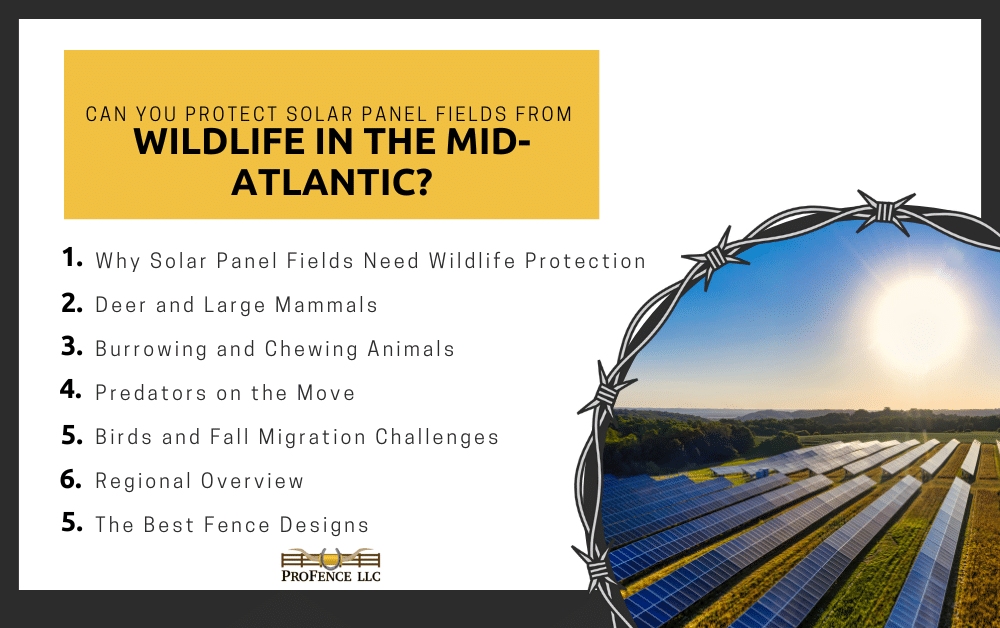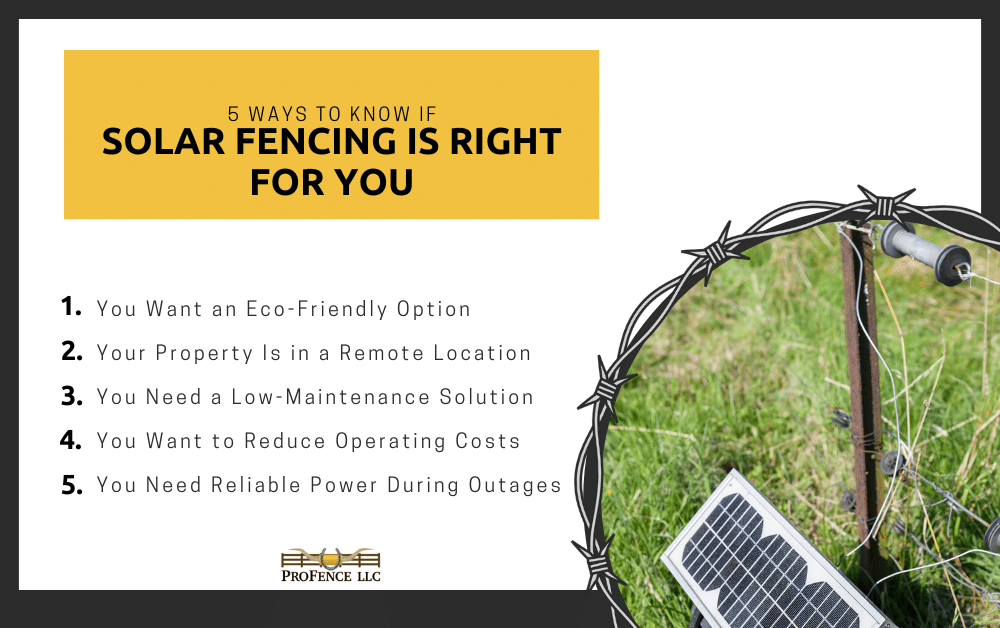As the demand for clean energy grows, solar panel installations are becoming more common on farms, rural properties, and even in wooded areas. But while these locations offer plenty of space and sunlight, they also come with a serious challenge—wildlife and livestock. Without proper solar panel fencing, your system is left vulnerable to damage that can lead to costly repairs, downtime, and even safety hazards.
That’s where solar panel fencing proves essential. More than just a boundary, it serves as the first line of defense between your investment and the animals that roam nearby. In this blog, we’ll break down how the right fencing can keep your system secure, efficient, and long-lasting.
Why Livestock and Solar Don’t Mix
Livestock Can Physically Damage Panels and Equipment
Large animals like cows, horses, and goats are naturally curious and may wander into solar installations if no fencing is in place. They can rub against racking systems, knock over mounting structures, or even crack solar panels with their weight. This kind of damage isn’t just cosmetic—it can compromise electrical connections and reduce energy output.
Proper solar panel fencing is designed to keep livestock out and away from sensitive equipment. It provides a clear and durable boundary, preventing animals from accidentally causing expensive or irreparable harm.
Risk of Livestock Following Farm Equipment Into Solar Fields
In agricultural settings, livestock often follow tractors, ATVs, or trucks. If solar installations are unfenced or gates are left open, animals can easily wander into restricted zones. This not only puts your panels at risk but also poses safety issues for both the animals and workers.
Installing solar panel fencing with secure, livestock-proof gates ensures that even during routine farm operations, access to your solar array remains controlled and safe.
Unintentional Wear and Tear from Regular Contact
Even if livestock don’t immediately break anything, consistent contact with solar hardware can cause long-term damage. Chewing on cables, pushing against support structures, or stepping into sensitive areas may weaken your setup over time.
Solar panel fencing prevents this kind of daily wear-and-tear by maintaining separation between animals and equipment—extending the lifespan of your investment.
Fence Recommendations for Livestock Zones
In areas with large animals, fencing should be built with strength in mind. Woven wire fencing, paired with wooden or steel posts, is a common and effective solution. It offers enough height and durability to block livestock while standing up to environmental stress.
For additional protection, consider adding electric fencing or double fencing around particularly sensitive areas. This layered approach reinforces your solar panel fencing strategy and helps mitigate high-risk interactions.
Common Wildlife Threats to Solar Installations
Rodents and Burrowing Animals Create Hidden Damage
Small animals like mice, rats, groundhogs, and rabbits might seem harmless, but they pose one of the biggest threats to solar panels. These animals are known to chew through wiring, insulation, and conduit lines. Once that happens, energy efficiency drops, and electrical shorts or fire risks increase.
Installing solar panel fencing with a buried or L-shaped bottom edge can help prevent burrowers from gaining access. This type of physical barrier not only keeps panels safe but also protects underground cabling.
Deer Can Jump In and Cause Accidental Breakage
Deer are active in many rural and suburban environments and can jump over low fencing with ease. If they make it into a solar array, they might knock into panels, snap wires, or become trapped—leading to injury and damage to both animals and equipment.
A tall solar panel fencing solution—like game fencing or reinforced mesh at least 8 feet high—helps block deer from entering your site in the first place. It’s a humane and effective way to avoid costly accidents.
Birds Can Nest in or Around Solar Components
Birds often build nests under or around solar panels and in inverter housings. While this may seem like a minor issue, nests can cause:
- Overheating from blocked airflow
- Corrosion from droppings
- Short circuits from debris buildup
To prevent this, solar panel fencing should be paired with bird deterrents like mesh screens, sloped panel designs, or ultrasonic repellents. This combined approach keeps your system cleaner, safer, and running more efficiently.
Wildlife Presence Increases Maintenance Needs
Even when animals don’t directly damage your system, their presence can increase maintenance costs. Tracks, droppings, and nesting materials require regular cleanup and inspections. These tasks take time, and if neglected, they can shorten the life of your system.
Well-placed solar panel fencing acts as a passive defense that reduces the frequency and urgency of wildlife-related maintenance—freeing up resources and keeping your array in better shape over time.
Fencing Solutions That Work
Welded Wire Fencing for Durability and Versatility
Welded wire fencing is a top choice for solar installations due to its strength and adaptability. It consists of galvanized steel wire that resists rust, corrosion, and weathering. The tightly spaced grid design makes it difficult for animals—both large and small—to squeeze through or chew.
When used as solar panel fencing, welded wire is effective in a wide range of environments, from farms to remote woodlands. It’s also visually unobtrusive, offering a clean and professional look while maintaining protection.
Electric Fencing as an Added Deterrent
Electric fencing can be installed on its own or added to an existing fence line for extra defense. It works especially well in areas with deer or predators, using a mild but memorable shock to keep animals away.
For solar installations in rural or off-grid locations, solar-powered electric fencing is a smart complement to traditional solar panel fencing. It’s energy-efficient, low-maintenance, and deters even the most persistent intruders.
Game or Deer Fencing for Tall Threats
In heavily wooded or high-wildlife areas, standard-height fences won’t cut it. Game or deer fencing is designed to be at least 7 to 8 feet tall and made of durable mesh or wire. It’s strong enough to stop deer from jumping in and light enough to be installed on uneven ground.
This type of solar panel fencing is ideal for perimeter protection where deer pressure is high but full-scale barriers would be too expensive or impractical.
Underground Mesh to Stop Digging Animals
Some animals don’t go through fences—they go under. Groundhogs, foxes, and rabbits are notorious for burrowing beneath panels and damaging wiring. To block them, install an underground barrier: either bury the fence 6–12 inches deep or lay an L-shaped mesh along the ground.
Incorporating this detail into your solar panel fencing strategy helps protect against hidden threats that standard fences often miss. It’s a small upgrade that delivers major long-term benefits.
Secure Gates and Access Points Matter
Even the best fence won’t work if gates are left open or unprotected. Make sure all access points are reinforced, lockable, and tall enough to match the fence line. Use self-closing hinges or digital locks where needed.
Incorporating secure gates into your solar panel fencing ensures that your installation remains protected without sacrificing convenience for maintenance crews or inspectors.
Benefits of Proper Solar Fencing
Prevents Costly Equipment Damage
Without a barrier, animals can chew through wires, crack solar panels, or collapse racking systems—all of which result in expensive repairs and potential downtime. Damage from livestock and wildlife isn’t just inconvenient; it can reduce your energy output and lead to significant financial losses.
Installing solar panel fencing provides a reliable way to shield your system from these threats. It’s a one-time investment that helps avoid ongoing repair bills and keeps your panels operating at peak performance.
Improves Safety for Workers and Animals
When animals have access to electrical equipment, the situation becomes dangerous for everyone. Curious livestock or wildlife could come into contact with energized components, leading to injury or death. Likewise, maintenance crews may encounter unexpected hazards when performing routine inspections.
Proper solar panel fencing helps create a clearly defined and secure boundary. This keeps both humans and animals safe and reduces the risk of injury-related liabilities on your property.
Enhances System Longevity and Efficiency
A fenced solar installation is better protected from the environment and less likely to face performance interruptions. Fewer disturbances mean more consistent energy production and fewer calls for emergency service or troubleshooting.
By reducing the physical and environmental stress placed on your system, solar panel fencing helps ensure your solar array lasts longer and maintains optimal output throughout its lifespan.
Reduces Maintenance Costs Over Time
Cleaning up animal waste, repairing chewed wires, and dealing with nests or burrows can become a recurring maintenance expense. Without fencing, these problems will likely keep coming back—and each visit from a technician adds to your overall costs.
With a good solar panel fencing solution in place, you reduce the frequency and severity of these issues. That means fewer interruptions, lower labor expenses, and more predictable upkeep.
Conclusion
Whether your solar panels are installed on farmland, in a rural field, or near wooded areas, protecting them with proper fencing is more than just a precaution—it’s a necessity. Wildlife and livestock can cause serious damage that affects performance, safety, and longevity. That’s why solar panel fencing should be a core part of any installation plan.
From keeping cattle out of racking systems to stopping burrowing rodents and deterring deer, the right fence reduces risks and saves money in the long run. Options like welded wire, electric fencing, and deer fencing offer targeted protection for different threats and environments. Combined with secure gates and underground mesh, these solutions create a complete defense system for your solar investment.
If you’re planning a solar installation—or already have one without a fence—it’s time to take action. Reach out to a professional fencing company like ProFence to design a customized solution that keeps your site secure, your equipment protected, and your energy flowing without interruption.







